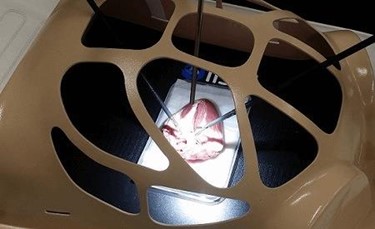New Robotic Surgery Platform Latest To Offer Tactile Response

A new surgical robot allows surgeons to “feel” their way through a procedure with a haptic feedback system. According to scientists at Deakin University and Harvard University, the HeroSurg system provides both tactile sensation and HD-quality 3D imaging for greater confidence and accuracy than is possible with current robotic laparoscopic systems.
Laparoscopic, or “key hole” surgeries, are significantly less invasive than “open” surgeries, requiring just a few small incisions and providing shorter recovery times, but the procedures do limit a surgeon’s field of vision and ability to feel differences in tissues while operating. Suren Krishnan, who in 2008 was the first surgeon to perform an ears, nose, and throat (ENT) operation with Intuitive’s Da Vinci surgical robot, assisted in the design of HeroSurg and stated that the “lack of tactile sensation” was the primary drawback to current robotic laparoscopic systems.
TransEnterix's Senhance Surgical Robotic System also offers haptic feedback capabilities, and has gained CE Mark approval, to date, for use in general surgery, gynecology, urology and thoracic surgery. A company representative tells MDO that TransEnterix is actively preparing a submission seeking U.S. FDA clearance, as well.
“Tactile feedback allows a surgeon to differentiate between tissues and to ‘feel’ delicate tissues weakened by infection or inflammation and dissect them more carefully,” said Krishnan in a press release. “Tactile feedback will allow us to use finer and more delicate sutures in microsurgery.” Because surgeons would be able to “feel” relative differences and stiffness of tissues, Krishnan added that surgeons using HeroSurg could identify cancerous tissue more easily than working with imaging alone.
The HeroSurg system was developed at the Deakin Institute for Intelligent Systems Research and Innovation (ISSRI) with input from scientists at Harvard University, and was recently introduced at the Australasian Simulation Congress in Victoria, Australia. In their demonstration, the researchers showed how sensors embedded into the instruments measured forces applied by surgeons, and then relayed sensory information, via vibrations, to the surgeons’ hands, reported New Atlas.
In addition to haptic feedback, the HeroSurg system offers collision avoidance capability, high-resolution 3D imaging, automatic patient/bed adjustment, and a more ergonomic workspace. Mohsen Moradi Dalvand, lead researcher on the project, stated that the system’s features offer greater confidence and safety to robotic surgery, and could allow surgeons to perform more complicated surgeries using less invasive methods.
Simulation Australasia CEO John Stewart said the technology would “change the way medicine was done,” and was impressed by the system’s potential for remote operation. “The best surgeons will be able to operate on patients on the other side of the world and the advancements in haptic technology mean they’re no longer just relying on sight,” said Stewart.
Several startups have launched surgical robots over the past few years, and large medtechs — such as Medtronic, Stryker, Smith & Nephew, and J&J’s Ethicon — have made sizeable investments in the technology. Johnson & Johnson recently launched Verb Surgical, a joint robotics surgery venture, with Verily. Medtronic recently partnered with Mazor Robotics and projects surgical robot revenue by 2019.
The Lancet recently published results from the first clinical trial comparing robotic surgery to traditional surgical procedures for patients with localized prostate cancer, though it showed “no statistical difference” in patient outcomes 12 weeks post-surgery. Trial participants will be followed for an additional two years to assess long-term outcomes.
EDIT: This article has been updated from a previous version, which stated that the HeroSurg System is the first robotic surgery platform to offer haptic feedback. We apologize for the error.
